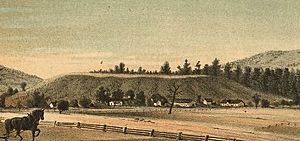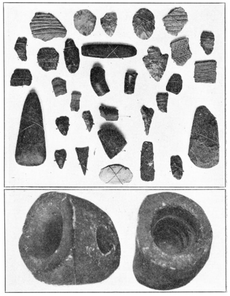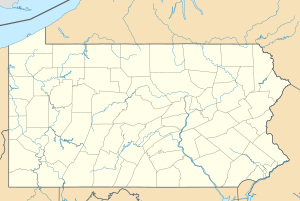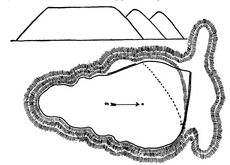Spanish Hill facts for kids
Quick facts for kids Spanish Hill |
|
|---|---|

Spanish Hill from the south, as depicted in an 1881 lithograph
|
|
| Location | Bradford County, Pennsylvania, USA |
| Coordinates | 41°59′45″N 76°32′58″W / 41.9959074°N 76.5493893°W |
| Elevation | 978 feet (298 m) |
Spanish Hill is a special hill in South Waverly, Pennsylvania. People have different ideas about what was built on it long ago. Some think early farmers made the structures. Others believe it was a Native American village or a fort.
This is because the hill matches descriptions of a place called Carantouan. This town was mentioned by an explorer named Étienne Brûlé. The Susquehannock Native Americans lived near the hill in the past. Many people, both experts and hobbyists, have explored the hill looking for old items. No one knows for sure where the name "Spanish Hill" came from, but there are many ideas.
Contents
What Spanish Hill Looks Like
In 1795, a traveler named François Alexandre Frédéric visited Spanish Hill. He said the hill looked like a "sugar loaf" and was about 100 feet tall. He also saw old "intrenchments" or earthworks on top. He noted a "breastwork" that looked like a parapet and a ditch.
Years later, in 1833, another visitor described a wall around the top of the hill. Inside this wall was a deep ditch. In 1898, I.P. Shepard drew a sketch of Spanish Hill. This sketch showed parts of the structures that were still visible. It also showed parts that had disappeared.
Shepard got help from a local person, Charles Henry Shepard. Charles remembered the "fortifications" as an earth wall with a trench behind it. This wall was about four or five feet high on the inside. People also found a dent in the ground. An expert named Beauchamp thought it was a place where corn was stored.
How Big Was Carantouan?
A historian named John S. Clark studied the area in the late 1800s. He thought Spanish Hill matched the description of Carantouan. This town was described by explorer Étienne Brûlé. Brûlé said Carantouan was a town surrounded by a palisade, which is a fence made of strong posts.
He wrote that about 800 warriors lived there, and 4,000 people in total. Brûlé also said the homes and forts were like those used by the Wyandot people. Clark's ideas came from his own surveys of the hill in 1878. He believed he saw old forts on top of the hill.
In 1932, a hobby archaeologist named Ellsworth C. Cowles dug at the bottom of the hill. He found 75 "postholes" in a line. These are holes where wooden posts once stood. He also found what he called a "huge animal" shape.
The Story of Spanish Hill

Spanish Hill was formed by melting glaciers long ago. It covers about 10 acres of land. The hill is part of the Sayre quadrangle area. It is about 978 feet above sea level. The hill rises about 230 feet above the nearby Chemung River floodplain.
Spanish Hill is located in South Waverly, Pennsylvania. It is in Bradford County, just south of the New York state border. This land was once home to the Susquehannock people. Experts have studied this hill for over 200 years.
Why Is It Called Spanish Hill?
No one knows exactly how Spanish Hill got its name. People traveling through the area between 1795 and 1804 called parts of the hill "Spanish Ramparts." Some of the first settlers in the region said that local Native Americans called the hill "Hispan" or "Espan."
In 1615, Samuel de Champlain sent Étienne Brûlé to this area. Brûlé was supposed to meet Native American tribes. Champlain hoped they would help him fight the Iroquois. Brûlé wrote about a town called Carantouan. This name meant "Big Tree" to some experts. Champlain's map from 1632 included this town.
In the early 1800s, a Native American man who lived near Spanish Hill refused to go up it. He was afraid of a deadly spirit living on top. He said the spirit had a loud voice and "made holes through Indians' bodies." An archaeologist named Louise Welles Murray thought this might mean cannon or musket fire.
Is Spanish Hill Carantouan?
In the early 1900s, researchers looked for a link between Carantouan and the hill's structures. Archaeologist L.D. Shoemaker found signs that Native Americans lived there. He found shell heaps, corn, and flint chips. He also found other tools.
However, in 1918, historian George P. Donehoo surveyed the site. He decided Spanish Hill could not be Carantouan. He said the hill was too steep to climb easily. He also noted a lack of water and old items on the hill.
Another expert, James Bennett Griffin, also found nothing interesting in 1931. But historian Deb Twigg thinks earlier digs and farming might have removed many items. She wrote that we shouldn't rule out Spanish Hill as Carantouan. More information is needed to be sure.
Digging for History
Spanish Hill was a popular spot for both expert digs and amateur collecting. According to Twigg, an archaeologist named Warren Moorehead "looted" the hill. This means he took many items, likely to sell them. Also, people looking for old items had searched the area heavily since the early 1800s.
On October 15, 1915, the Historical Society of Bradford County, Pennsylvania, placed a memorial on Spanish Hill. This was to celebrate 300 years since Brûlé arrived in the area. Later, in 1939, artist Musa McKim painted the hill. Her mural was called "Spanish Hill and the Early Inhabitants of the Vicinity." It was displayed in the United States Post Office in nearby Waverly, New York.
In 1970, Spanish Hill was almost destroyed. People wanted to use its earth to fill in for a highway. But local hobby archaeologist Ellsworth Cowles helped stop this plan.
(subscription needed)



